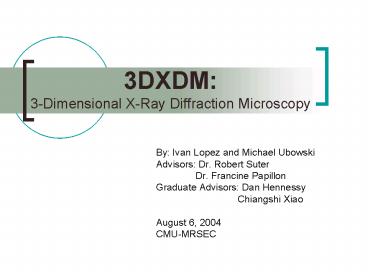3DXDM: 3Dimensional XRay Diffraction Microscopy - PowerPoint PPT Presentation
1 / 19
Title:
3DXDM: 3Dimensional XRay Diffraction Microscopy
Description:
Dr. Francine Papillon. Graduate Advisors: Dan Hennessy. Chiangshi Xiao. August 6, 2004 ... To create a non-destructive method of obtaining a material's microstructure. ... – PowerPoint PPT presentation
Number of Views:109
Avg rating:3.0/5.0
Title: 3DXDM: 3Dimensional XRay Diffraction Microscopy
1
3DXDM3-Dimensional X-Ray Diffraction Microscopy
- By Ivan Lopez and Michael Ubowski
- Advisors Dr. Robert Suter
- Dr. Francine Papillon
- Graduate Advisors Dan Hennessy
- Chiangshi Xiao
- August 6, 2004
- CMU-MRSEC
2
Goal/Introduction 3DXDM
- To create a non-destructive method of obtaining a
materials microstructure. - Allows for the texture mapping of changes in
microstructure due to - Heat Treatments
- Fractures
- Plastic Deformation
3
Experimental Setup
Detector
Beam Stop
1mm Diameter Sample
4
Experimental Setup
5
Michaels Project Goal
- Determine the Texture of individual grains
- Characterize the cause of the texture as
- Stresses within grains
- Dislocations
- Combination of both
6
Approach
- Obtain the grain orientation based on analysis of
1 interval diffraction images. - Compare with data taken at 1/100 degree
intervals. - Characterize grains as splayed or almost perfect
blocks. - Splayed planes are stresses.
- Almost perfect block planes have dislocations.
7
Aluminum Single Crystal Analysis
- Pre and Post Annealed Data.
- Eight Layers at 100 rotations per layer.
- Data is first analyzed using an image enhancement
program and then simulated using a Monte Carlo
fitting technique. - Color maps of different layers in the
pre-annealed data set show possible trend.
8
Average Mis-Orientation
- Comparison of average mis-orientation between Pre
and Post annealing. - Decreases in average mis-orientation yields
relief in stresses and dislocations. - Average mis-orientation based on overall average
orientation - Results show that our technique maybe be able
detect the difference.
9
Future Work
- Analyze the 1/100 degree data.
- Compare Results with 1 interval data.
- Characterize the texture.
10
MgO Sample Goal
- To characterize and eliminate the diffuse
scattering, caused by segregation of an amorphous
phase (Si and Ca oxides) at the grain boundaries,
in order to extract diffraction spots from that
region.
L1
L2
L3
z Layer 1 w 48o
11
Approach/Results I
- Average images with similar diffuse scattering
and subtract that from each image along with the
background.
L1
L2
L3
z Layer 1 w 48o
12
Difficulties/Problems I
- Intensity of the diffuse scattering increases
with each layer (z-direction) and with each w
while the intensities of the diffraction spots
remain quite constant.
13
Difficulties/Problems I
- Diffuse scattering does not subtract in deeper
layers, as can be seen by MgO-1250 (5th Layer)
before and after.
- Nature of the spot changes throughout each set
of detector images due to the procedure in which
the images were taken.
Before
After
z Layer 5 w 50o
14
Approach/Results II
- Fit a function to the curve of the intensity and
subtract this from the image. - Polynomials of various degrees were used.
L1
z Layer 1 w 48o
z Layer 5 w 50o
15
Difficulties/Problems II
- For some images the nature of the Spot didnt
allow for an accurate polynomial fit. - Spots are left that are not true diffraction
spots. - Simulation will hopefully disregard these
artificial spots.
L1
z Layer 8 w 25o
16
Fluorescence
- Atoms within the sample absorb energy (photons)
from the incident beam and reach an excited
state. Upon returning to stable states, the
atoms emit more photons.
17
Filtering the Fluorescence
- Insert a filter between the sample and the
detector. - Filter used was a piece of computer printer paper
taped over the detector.
With Filter
Without Filter
18
Future work
- Run a simulation of the cleaned up Mgo data set.
- Next APS visit, obtain a detailed MgO data set
with the filter in place.
19
APS Pictures
Questions?































